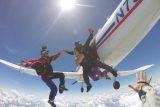The physics of skydiving: Such riveting stuff! One of the most common points of curiosity when it comes to the science of jumpin’ is, predictably, how fast do you go when skydiving. After all: Everybody loves speed.
Most folks know that the average speed of freefall for a tandem pair is about 120 miles per hour, since that figure is tossed around so often. 120 miles per hour has a hallowed status in our culture, even beyond skydiving: after all, it sits at the very tippy-top of a US speedometer dial (even though the car itself almost certainly can’t even go that fast), so it basically defines speed, in a way.
Also interestingly: 120 miles per hour is the exact wind speed at which a standing person loses the ability to stay put. (XKCD does a much better job of illustrating this point in stick figures than I could hope to with words.)
Trivia aside, there’s more to the story of 120 miles per hour than a first-time skydiver could possibly guess. Ready to have your mind blown? Pull up a chair.
1. You’ll Have No Idea You’re Going That Fast.
If you were in the passenger seat of a Nascar vroomer, you’d feel every iota of that 120. The roar of the pavement, the zip of the landscape past your window, the wind howling around the car and the pressure of your body against the seat would make sure you did. In skydiving–not at all.
Sure, you’ll know in some cerebral sense that you’re bombing along in freefall at 120, but you’ll have no sense of that speed. You’ll have no reference points, for one thing–unless you pass a cloud, in which case your true speed will be magically revealed to you (in a super-fun way).
2. You Won’t Feel That “Falling” Feeling.
The pressure-y zoom of a race car puts speed in a direct visceral context. Again: that’s not something we experience in skydiving. The sky’s friendly air molecules work together to make you feel supported underneath your torso and every limb, but they won’t shove against you like a racecar seat. You’ll almost certainly be surprised by how peaceful and confidence-inspiring the feeling is. You’ll likely love it.
3. People Fall At Slightly Different Rates Of Speed.
There are a number of factors that can adjust that 120-mile-per-hour figure. Heavier tandem pairs fall faster; tandem pairs with baggier clothing fall slower (because of drag); tandem pairs in hot weather fall faster (because the air molecules are further apart)l tandem pairs in cold weather have a few more molecules slowing them down.
4. There’s Still Speed To Enjoy After Freefall!
The parachute will slow down your descent significantly, but you’ll still get to enjoy a canopy descent rate that approximates a car’s city-street speeds. When your tandem instructor brings you in for your triumphant landing, he/she puts the brakes on just as smoothly as a top-shelf chauffeur.
More questions? Ask away! We’re happy to address them on our blog.





